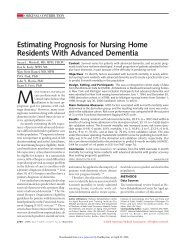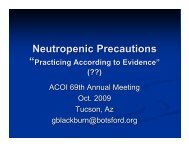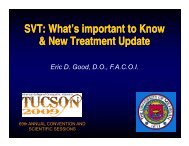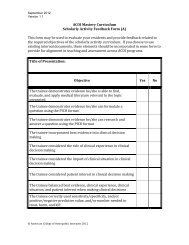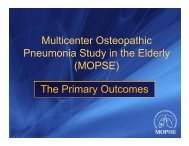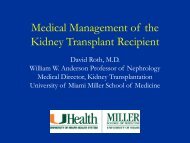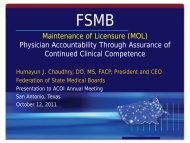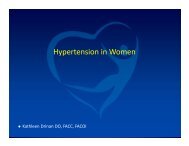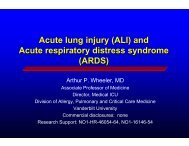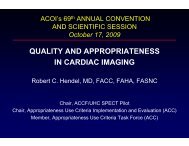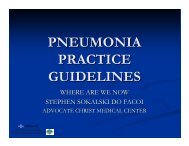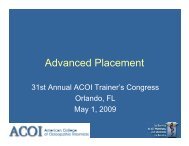Acute Coronary Syndrome
Acute Coronary Syndrome
Acute Coronary Syndrome
You also want an ePaper? Increase the reach of your titles
YUMPU automatically turns print PDFs into web optimized ePapers that Google loves.
<strong>Acute</strong> <strong>Coronary</strong> <strong>Syndrome</strong>:<br />
Thoughts on primary and secondary treatment<br />
Kenneth Tobin, DO,FACC, FACOI<br />
Clinical Assistant Professor<br />
Director, Chest Pain Center<br />
University of Michigan Medical Center<br />
Ann Arbor, MI.
Case 1<br />
• 67 year old male<br />
• h/o HTN<br />
• Family h/o CAD (father had MI at 46 y/o, brother<br />
had MI at 56 y/o)<br />
• Current smoker (1/2 PPD)<br />
• Meds: Amlopidine, ASA 81 mg QD<br />
• BMI: 31, not physically active
Case 1<br />
• Exam:<br />
• 142/74, HR 88, RR 16<br />
• Screening Labs:<br />
• Total C: 201<br />
• LDL-c: 134<br />
• HDL: 35<br />
• Trig: 255<br />
• FBS: 138<br />
• HA1c: 5.5<br />
• SCr 1.4<br />
• Hg 12.2
Case 1<br />
• Pt. calls office and related c/o exertional CP for<br />
the last 4 – 6d<br />
days.<br />
• Pt advised to take his daily ASA ( if he hasn’t<br />
already), and go directly to an ED for further<br />
evaluation.
Case 1<br />
• Arrival to ED:<br />
• ECG
Case 1<br />
• Physical Exam (ED)<br />
• Currently CP free<br />
• Hemodynamically stable<br />
• O 2 sat normal<br />
• Started t on IV heparin, given ASA 162 mg (pt.<br />
took 162 mg before arriving)<br />
• Troponins drawn:<br />
• O hour: < 0.10<br />
• 6 hour repeat: 0.82
Case 1<br />
• Decision made to pursue invasive strategy:
Case 1<br />
• Pt d/c day 3<br />
• Atorvastatin 80 mg QD<br />
• Plavix 75 mg. QD for 12 months<br />
• ASA 325 mg QD for 3 months, then can<br />
decrease to 81 mg QD<br />
• Metoprolol Succinate 50 mg QD<br />
• Zetril 20 mg QD<br />
• Norvasc discontinued
Evidence Based Data
Spectrum of <strong>Acute</strong> <strong>Coronary</strong> <strong>Syndrome</strong>s<br />
Presentation<br />
Ischemic Discomfort<br />
at Rest<br />
Emergency<br />
Department<br />
No ST-Segment Segment<br />
Elevation<br />
ST-Segment<br />
Elevation<br />
In-Hospital<br />
+ +<br />
+<br />
Unstable Non-Q-wave MI<br />
Angina<br />
( : positive cardiac biomarker)<br />
Q-wave MI
Variables Used in the TIMI Risk Score<br />
•Age ≥ 65 years<br />
•At least 3 risk factors for CAD<br />
•Prior coronary stenosis of ≥ 50%<br />
•ST-segment deviation on ECG presentation<br />
•At least 2 anginal events in prior 24 hours<br />
•Use of aspirin in prior 7 days<br />
•Elevated serum cardiac biomarkers<br />
The TIMI risk score is determined by the sum of the presence of the above 7 variables at admission. 1 point is given for each variable.<br />
Primary coronary stenosis of 50% or more remained relatively insensitive to missing information and remained a significant predictor of<br />
events. Antman EM, et al. JAMA 2000;284:835–42.<br />
TIMI = Thrombolysis in Myocardial Infarction.
Causes of UA/NSTEMI*<br />
• Thrombus or thromboembolism, usually arising on disrupted or<br />
eroded plaque<br />
• Occlusive thrombus, usually with collateral vessels†<br />
• Subtotally occlusive thrombus on pre-existing plaque<br />
• Distal microvascular thromboembolism from plaque-associated<br />
thrombus<br />
• Thromboembolism from plaque erosion<br />
• Non–plaque-associated coronary thromboembolism<br />
• Dynamic obstruction (coronary spasm‡ or vascoconstriction)<br />
of epicardial and/or microvascular vessels<br />
• Progressive mechanical obstruction to coronary flow<br />
• <strong>Coronary</strong> arterial inflammation<br />
• Secondary UA<br />
• <strong>Coronary</strong> artery dissection§<br />
*These causes are not mutually exclusive; some patients have 2 or more causes. †DeWood MA, et al. N Engl J Med 1986;315:417–23. ‡May occur<br />
on top of an atherosclerotic plaque, producing missed-etiology angina or UA/NSTEMI. §Rare. Modified with permission from Braunwald E. Circulation<br />
1998;98:2219–22. Anderson JL, et al. J Am Coll Cardiol. 2007;50:e1-e157, Table 3.<br />
16
I<br />
IIa IIb III<br />
Updated Guidelines<br />
Classes of Recommendations<br />
Intervention is useful and effective<br />
Evidence conflicts/opinions differ but<br />
leans towards efficacy<br />
Evidence conflicts/opinions differ but<br />
leans against efficacy<br />
Intervention is not useful/effective and<br />
may be harmful
Identification of Patients<br />
at Risk of UA/NSTEMI<br />
New<br />
Section<br />
I<br />
IIa IIb III<br />
Primary care providers should evaluate the<br />
presence and status of control of major risk<br />
factors for coronary heart disease (CHD) for all<br />
patients at regular intervals (approximately every<br />
3 to 5 years).<br />
I<br />
IIa IIb III<br />
Ten-year risk (National Cholesterol Education<br />
Program [NCEP] global risk) of developing<br />
symptomatic CHD should be calculated for all<br />
patients who have 2 or more major risk factors to<br />
assess the need for primary prevention strategies<br />
(1,2).
Initial Chest Pain<br />
Evaluation<br />
Symptoms Suggestive of ACS<br />
Possible ACS<br />
Definite ACS<br />
(–) ECG;<br />
Normal biomarkers<br />
Observe; repeat ECG,<br />
markers at 4-8 hrs<br />
No ST <br />
ST-T ’s,<br />
chest pain,<br />
markers<br />
ST <br />
Use MI<br />
Guidelines<br />
No recurrent pain;<br />
(–) follow-up studies<br />
Recurrent pain;<br />
(+) follow-up studies<br />
Stress test; LV<br />
function if ischemia<br />
(–) test: outpt follow-up<br />
(+) test<br />
Admit, Use <strong>Acute</strong><br />
Ischemia Pathway
Mortality in Non-ST<br />
ACS Patients With<br />
Myocardial Infarction During Hospitalization<br />
20<br />
Patients with MI within<br />
72 hours (n=593)<br />
18.3%<br />
% Mo<br />
ortality<br />
15<br />
10<br />
5<br />
Patients without MI within<br />
72 hours (n=8,868)<br />
5.5%<br />
12.8% <br />
(P = 0.0001)<br />
30 60 90 120 150 180<br />
Days following randomization<br />
Fintel D, ACC, 2000
Variables Used in the TIMI Risk Score<br />
•Age ≥ 65 years<br />
•At least 3 risk factors for CAD<br />
•Prior coronary stenosis of ≥ 50%<br />
•ST-segment deviation on ECG presentation<br />
•At least 2 anginal events in prior 24 hours<br />
•Use of aspirin in prior 7 days<br />
•Elevated serum cardiac biomarkers<br />
The TIMI risk score is determined by the sum of the presence of the above 7 variables at admission. 1 point is given for each variable.<br />
The TIMI risk score is determined by the sum of the presence of the above 7 variables at admission. 1 point is given for each variable.<br />
Primary coronary stenosis of 50% or more remained relatively insensitive to missing information and remained a significant predictor of<br />
events. Antman EM, et al. JAMA 2000;284:835–42.<br />
TIMI = Thrombolysis in Myocardial Infarction.
TIMI<br />
Risk<br />
Score<br />
TIMI Risk Score<br />
All-Cause Mortality, New or Recurrent MI, or Severe<br />
Recurrent Ischemia Requiring Urgent Revascularization<br />
Through 14 Days After Randomization %<br />
0-1 47 4.7<br />
2 8.3<br />
3 13.2<br />
4 19.9<br />
5 26.22<br />
6-7 40.9<br />
Reprinted with permission from Antman EM, et al. JAMA 2000;284:835–42. Copyright © 2000, American Medical Association. All Rights reserved.<br />
The TIMI risk calculator is available at www.timi.org.<br />
Anderson JL, et al. J Am Coll Cardiol 2007;50:e1–e157, Table 8.<br />
22<br />
TIMI = Thrombolysis in Myocardial Infarction.
Lipid Management<br />
I<br />
IIa IIb III<br />
I<br />
I<br />
IIa IIb III<br />
IIa IIb III<br />
Lipid management should include assessment of<br />
a fasting lipid profile for all patients, within 24 h<br />
of hospitalization.<br />
Statins, in the absence of contraindications and<br />
regardless of baseline LDL-C and diet<br />
modification, should be given to post-UA/<br />
NSTEMI pts, including post-revascularization pts.<br />
For hospitalized patients, lipid-lowering<br />
medications should be initiated before discharge.<br />
24
Lipid Management<br />
I<br />
IIa IIb III<br />
New Lower<br />
LDL-C Goal<br />
For UA/NSTEMI patients with elevated LDL-C<br />
(≥ 100 mg per dL), cholesterol-lowering therapy<br />
should be initiated or intensified to achieve an<br />
LDL-C < 100 mg per dL.<br />
Further titration to less than 70 mg per dL is<br />
reasonable. (Class IIa, Level of Evidence: A)<br />
I<br />
IIa IIb III<br />
Therapeutic options to reduce non–HDL-C are<br />
recommended, d including more intense LDL-C–<br />
lowering therapy.<br />
*Non-HDL-C = total cholesterol minus HDL-C<br />
25
Pravastatin Or atorVastatin Evaluation and<br />
Infection Therapy–Thrombolysis Thrombolysis In Myocardial<br />
Infarction 22 (PROVE-IT TIMI 22)<br />
• 4,162 patients within 10 d of ACS<br />
•40 mg pravastatin vs 80 mg atorvastatin daily<br />
•↓ All-cause death, MI, UA requiring hosp, revasc & stroke @ 2 y by<br />
atorvastatin<br />
― Median LDL-C ↓ (62 vs 95 mg/dL)<br />
Cannon CP, et al. N Engl J Med 2004;350:1495–504.
Blood Pressure Control<br />
I<br />
IIa IIb III<br />
New BP<br />
Levels<br />
Blood pressure control according to JNC 7<br />
guidelines* is recommended (i.e., BP < 140/90<br />
mm Hg or < 130/80 mm Hg if the patient has<br />
diabetes mellitus or chronic kidney disease).<br />
*Chobanian AV, et al. JAMA 2003;289:2560-2572.<br />
JNC 7 = 7 th report of the Joint National Committee on Prevention, Detection, Evaluation and Treatment of High Blood Pressure.
Diabetes Mellitus<br />
I<br />
I<br />
I<br />
IIa IIb III<br />
IIa IIb III<br />
IIa IIb III<br />
Diabetes management should include lifestyle and<br />
pharmacotherapy measures to achieve a nearnormal<br />
HbA1c level of < 7%.<br />
Diabetes management should also include the<br />
following:<br />
a. Vigorous modification i of other risk factors (e.g.,<br />
physical activity, weight management, BP control,<br />
and cholesterol management) as recommended<br />
should be initiated and maintained.<br />
It is useful to coordinate the patient’s diabetic care<br />
with the patient’s primary care physician or<br />
endocrinologist.
Smoking Cessation<br />
I<br />
IIa IIb III<br />
Smoking cessation and avoidance of exposure to<br />
environmental tobacco smoke at work and home<br />
are recommended.<br />
Cessation<br />
Emphasized<br />
Follow-up, referral to special programs, or<br />
pharmacotherapy (including nicotine<br />
replacement) is useful, as is adopting a stepwise<br />
strategy aimed at smoking cessation (the 5 As<br />
are: Ask, Advise, Assess, Assist, and Arrange).
Weight Management<br />
I<br />
IIa IIb III<br />
New<br />
Weight management, as measured by body<br />
mass index (BMI) and/or waist circumference,<br />
should be assessed on each visit. A BMI of 18.5<br />
to 24.9 kg per m 2 and a waist circumference<br />
(measured horizontally at the iliac crest) of < 40<br />
inches for men and < 35 inches for women is<br />
recommended.
Physical Activity<br />
I<br />
IIa IIb III<br />
New<br />
Cardiac rehabilitation/secondary prevention<br />
programs are recommended for patients with<br />
UA/NSTEMI, particularly those with multiple<br />
modifiable risk factors and/or those moderate- to<br />
high-risk patients in whom supervised exercise<br />
training is particularly warranted.
Depression<br />
I<br />
IIa IIb III<br />
It is reasonable to consider screening UA/NSTEMI<br />
patients for depression and refer/treat when<br />
indicated.<br />
New
Clinical Assessment<br />
I<br />
IIa IIb III<br />
Patients with symptoms that may represent ACS<br />
should not be evaluated over the telephone, but<br />
should be referred to a facility that allows<br />
evaluation by a physician i and the recording of a<br />
12-lead ECG and biomarker determination (e.g.,<br />
an emergency department [ED] or other acute<br />
care facility).
Early Risk Stratification<br />
I<br />
IIa IIb III<br />
A rapid clinical determination of the likelihood<br />
risk of obstructive CAD (i.e., high, intermediate, or<br />
low) should be made in all patients with chest<br />
discomfort or other symptoms suggestive of an<br />
ACS and considered in patient management.<br />
I<br />
IIa IIb III<br />
Patients who present with chest discomfort or<br />
other ischemic symptoms should undergo early<br />
risk stratification for the risk of cardiovascular<br />
events (e.g., death or [re]MI) that focuses on<br />
history, including anginal symptoms, physical<br />
findings, ECG findings, gs,a and dbo biomarkers so of cardiac<br />
dac<br />
injury, and results should be considered in<br />
patient management.
Early Risk Stratification<br />
I<br />
IIa IIb III<br />
Patients with negative cardiac biomarkers within<br />
6 h of the onset of symptoms consistent t with ACS<br />
should have biomarkers remeasured in the time<br />
frame of 8 to 12 h after symptom onset. (The<br />
exact timing of serum marker measurement<br />
should take into account the uncertainties often<br />
present with the exact timing of onset of pain and<br />
the sensitivity, precision, and institutional norms<br />
of the assay being utilized as well as the release<br />
kinetics of the marker being measured.)<br />
I<br />
IIa IIb III<br />
The initial evaluation of the patient with<br />
suspected ACS should include the consideration<br />
of noncoronary causes for the development of<br />
unexplained symptoms.
Timing of Release of Various Biomarkers<br />
After <strong>Acute</strong> Myocardial Infarction<br />
Shapiro BP, Jaffe AS. Cardiac biomarkers. In: Murphy JG, Lloyd MA, editors. Mayo Clinic Cardiology: Concise Textbook. 3 rd ed. Rochester, MN:<br />
Mayo Clinic Scientific Press and New York: Informa Healthcare USA, 2007:773–80.<br />
Anderson JL, et al. J Am Coll Cardiol 2007;50:e1–e157, Figure 5.<br />
36
Immediate Management<br />
I<br />
IIa IIb III<br />
The history, physical examination, 12-lead<br />
ECG, and initial cardiac biomarker tests<br />
should be integrated to assign patients with<br />
chest pain into 1 of 4 categories:<br />
1) a noncardiac diagnosis<br />
2) chronic stable angina<br />
3) possible ACS<br />
4) definite it ACS.
Immediate Management<br />
I<br />
IIa IIb III<br />
Major<br />
Change<br />
Patients with probable or possible ACS but whose<br />
initial 12-lead ECG and cardiac biomarker levels<br />
are normal should be observed in a facility with<br />
cardiac monitoring (e.g., chest pain unit or<br />
hospital telemetry ward), and repeat ECG (or<br />
continuous 12-lead ECG monitoring) and repeat<br />
cardiac biomarker measurement(s) should be<br />
obtained at predetermined, specified time<br />
intervals*.<br />
*See Section 2.2.8 in Anderson JA, et al. J Am Coll Cardiol 2007:50:e1-e157.<br />
e157.
Early Hospital Care
Anti-Ischemic Therapy<br />
I<br />
IIa IIb III<br />
Major<br />
Change<br />
Oral beta-blocker blocker therapy should be initiated<br />
within the first 24 h for patients who do not have<br />
1 or more of the following:<br />
1) signs of HF<br />
2) evidence of a low-output state<br />
3) increased risk* for cardiogenic shock<br />
4) other relative contraindications to beta<br />
blockade (PR interval greater than 0.24 s,<br />
second or third degree heart block, active<br />
asthma, or reactive airway disease).<br />
*Risk factors for cardiogenic shock (the greater the number of risk factors present, the higher the risk of developing cardiogenic<br />
shock): age greater than 70 years, systolic blood pressure less than 120 mmHg, sinus tachycardia greater than 110 or heart rate less<br />
than 60, increased time since onset of symptoms of UA/NSTEMI. Chen ZM, et al. Lancet 2005;366:1622–32.
Antiplatelet Therapy<br />
I<br />
IIa IIb III<br />
Aspirin should be administered to UA/NSTEMI<br />
patients as soon as possible after hospital<br />
presentation and continued indefinitely in<br />
patients not known to be intolerant of that<br />
medication.<br />
I<br />
IIa IIb III<br />
LD added<br />
Clopidogrel (loading dose [LD] followed by daily<br />
maintenance dose) should be administered to<br />
UA/NSTEMI patients who are unable to take ASA<br />
because of hypersensitivity or major<br />
gastrointestinal intolerance.<br />
*Some uncertainty exists about optimum dosing of clopidogrel. Randomized trials establishing its efficacy and providing data on bleeding risks<br />
used a loading dose of 300 mg orally followed by a daily oral maintenance dose of 75 mg. Higher oral loading doses such as 600 or 900 mg of<br />
clopidogrel more rapidly inhibit platelet aggregation and achieve a higher absolute level of inhibition of platelet aggregation, but the additive<br />
clinical efficacy and the safety of higher oral loading doses have not been rigorously established.
Antiplatelet Therapy<br />
I<br />
IIa IIb III<br />
New<br />
In UA/NSTEMI pate patients ts with a history yo<br />
of<br />
gastrointestinal bleeding, when ASA and<br />
clopidogrel are administered alone or in<br />
combination, drugs to minimize the risk of<br />
recurrent gastrointestinal bleeding (e.g., protonpump<br />
inhibitors) should be prescribed<br />
concomitantly.
Selection of Initial Treatment Strategy: Initial<br />
Invasive Versus Conservative Strategy<br />
Invasive<br />
Recurrent angina/ischemia at rest with low-level activities despite<br />
intensive medical therapy<br />
Elevated cardiac biomarkers (TnT or TnI)<br />
New/presumably new ST-segment depression<br />
Signs/symptoms of heart failure or new/worsening mitral regurgitation<br />
High-risk findings from noninvasive testing<br />
Hemodynamic instability<br />
Sustained ventricular tachycardia<br />
PCI within 6 months<br />
Prior CABG<br />
High risk score (e.g., TIMI, GRACE)<br />
Reduced left ventricular function (LVEF < 40%)<br />
Conservative<br />
Low risk score (e.g., TIMI, GRACE)<br />
Patient/physician presence in the absence of high-risk features
Initial Conservative Versus Initial Invasive<br />
Strategies<br />
I<br />
IIa IIb III<br />
An early invasive strategy* is indicated in<br />
UA/NSTEMI patients who have refractory angina<br />
or hemodynamic or electrical instability (without<br />
serious comorbidities or contraindications to such<br />
procedures).<br />
I<br />
IIa IIb III<br />
An early invasive strategy* is indicated in initially<br />
stabilized UA/NSTEMI patients (without serious<br />
comorbidities or contraindications to such<br />
procedures) who have an elevated risk for clinical<br />
events.<br />
*Diagnostic angiography with intent to perform revascularization.
Risk Stratification Before Discharge<br />
I<br />
IIa IIb III<br />
Prompt angiography without noninvasive risk<br />
stratification should be performed for failure of<br />
stabilization with intensive medical treatment.<br />
I<br />
IIa IIb III<br />
IIa → I<br />
III A noninvasive test (echocardiogram or<br />
radionuclide angiogram) is recommended to<br />
evaluate LV function in patients with definite ACS<br />
who are not scheduled for coronary angiography<br />
and left ventriculography.
Antiplatelet Therapy<br />
I<br />
IIa IIb III<br />
See recommendation for LOE<br />
Major<br />
Change<br />
For UA/NSTEMI patients treated medically<br />
without stenting, aspirin* (75 to 162 mg per day)<br />
should be prescribed indefinitely (Level of<br />
Evidence: A)<br />
clopidogrel† †( (75 mg gp per day) should be<br />
prescribed for at least 1 month (Level of<br />
Evidence: A) and ideally for up to 1 year. (Level of<br />
Evidence: B)<br />
*For ASA-allergic patients, use clopidogrel alone (indefinitely), or try aspirin desensitization.<br />
†For clopidogrel-allergic patients, use ticlopidine 250 mg by mouth twice daily.<br />
46
Antiplatelet Therapy<br />
I<br />
IIa IIb III<br />
See recommendation for LOE<br />
New<br />
For UA/NSTEMI patients treated with bare-metal<br />
stents, aspirin* 162 to 325 mg per day should be<br />
prescribed for at least 1 month (Level of<br />
Evidence: B), then continued indefinitely at a<br />
dose of 75 to 162 mg per day (Level of Evidence:<br />
A)<br />
Clopidogrel should be prescribed at a dose of 75<br />
mg per day for a minimum of 1 month and ideally<br />
for up to 1 year (unless the patient is at increased<br />
risk of bleeding; then it should be given for a<br />
minimum of 2 weeks). (Level of Evidence: B)<br />
47<br />
*For ASA-allergic patients, use clopidogrel alone (indefinitely), or try aspirin desensitization.
Antiplatelet Therapy<br />
I<br />
IIa IIb III<br />
New<br />
For UA/NSTEMI patients treated with drug-eluting<br />
stents (DES), aspirin 162 to 325 mg per day<br />
should be prescribed for at least 3 months after<br />
sirolimus-eluting stent implantation and 6<br />
months after paclitaxel-eluting stent implantation<br />
then continued indefinitely at a dose of 75 to 162<br />
mg per day.<br />
I<br />
IIa IIb III<br />
Clopidogrel 75 mg daily should be given for at<br />
least 12 months to all post-PCI patients receiving<br />
DES.<br />
New<br />
*For ASA-allergic patients, use clopidogrel alone (indefinitely), or try aspirin desensitization.<br />
48
Cardiac Rehabilitation<br />
I<br />
IIa IIb III<br />
New<br />
Cardiac rehabilitation/secondary prevention<br />
programs, when available, are recommended for<br />
patients with UA/NSTEMI, particularly those with<br />
multiple modifiable risk factors and those<br />
moderate- to high-risk patients in whom<br />
supervised exercise training is warranted.
I<br />
IIa IIb III<br />
Hospital Care<br />
Conservative vs. Invasive Strategies<br />
Early invasive strategy in high-risk<br />
patients with any of the following:<br />
- Recurrent ischemia, despite meds<br />
- Elevated Troponin I or T<br />
-New ST-segment depression<br />
- New CHF symptoms<br />
- High-risk stress test findings<br />
- LV dysfunction (EF < 40%)<br />
- Hemodynamic instability, sustained VT<br />
- PCI within 6 months, prior CABG
Discharge/Post-Discharge Medications<br />
I<br />
IIa IIb III<br />
ASA, if not contraindicated<br />
Clopidogrel, when ASA contraindicated<br />
Aspirin + Clopidogrel, for up to 9 months<br />
-blocker, if not contraindicated<br />
Lipid id agents + diet, if LDL >130 mg/dL<br />
ACE Inhibitor: CHF, EF < 40%, DM, or HTN
Risk Factor Modification<br />
I<br />
IIa IIb III<br />
Smoking Cessation Counseling<br />
Dietary Counseling and Modification<br />
Cardiac Rehabilitation Referral<br />
HTN Control (BP < 130/85 mm Hg)<br />
Tight Glycemic Control in Diabetics
Case Review using TIMI risk<br />
score assessment
Variables Used in the TIMI Risk Score<br />
•Age ≥ 65 years<br />
•At least 3 risk factors for CAD<br />
•Prior coronary stenosis of ≥ 50%<br />
•ST-segment deviation on ECG presentation<br />
•At least 2 anginal events in prior 24 hours<br />
•Use of aspirin in prior 7 days<br />
•Elevated serum cardiac biomarkers<br />
The TIMI risk score is determined by the sum of the presence of the above 7 variables at admission. 1 point is given for each variable.<br />
The TIMI risk score is determined by the sum of the presence of the above 7 variables at admission. 1 point is given for each variable.<br />
Primary coronary stenosis of 50% or more remained relatively insensitive to missing information and remained a significant predictor of<br />
events. Antman EM, et al. JAMA 2000;284:835–42.<br />
TIMI = Thrombolysis in Myocardial Infarction.
• 67 year old male<br />
Case 1



